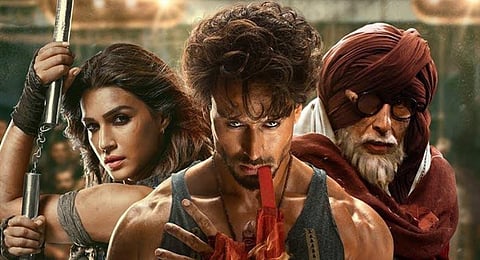

Post-apocalyptic fiction is a genre that probably originated from a developed country’s worst fears. Aliens almost always attack the White House. A drone shot of a nuclear-bombed wasteland is incomplete without a glimpse of the Statue of Liberty and its missing head. Indian filmmakers rarely come up with dystopian films. Probably, because they can’t imagine a world worse than the one they currently live in. And god forbid if they do, it’s in the form of a Ganapath, a developing country’s cinematic nightmare.
It’s odd to see director Vikas Bahl, best known for heart-warmers like Chillar Party, Queen and Shaandaar, try his hand at dystopia. But who am I kidding? Ganapath doesn’t even qualify as an attempt.
It’s a two-hour test of the audience’s resilience to endure Tiger Shroff’s routine air flips. The storytelling and world-building is plain, juvenile and as imaginative as a child weaving the plot of a comic book on the last page of their notebook.
Amitabh Bachchan’s baritone introduces us to a world destroyed by nuclear war which led to a refugee crisis. If they weren’t already, people are now strictly divided among the ameer (rich) and the gareeb (poor). The rich reside in ‘Silver City’, whose visuals are straight out of a promotional video for a housing project.
The poor get the prosaic ‘gareeb basti’. A metal wall (which is so badly CGI-ed, it is seldom shown) divides the land between the rich and the poor. So that they don’t kill each other over the depleting resources, Amitabh’s local wise-man Dalapathi, introduces the gareebs to akhadas (fighting arena), in which they can battle to vent their frustration against the privileged. The rich make this also into a business and choose the best fighters from the bastis to fight for them in betted-on, ring matches. It’s basically Hunger Games without the societal subtext or the narrative coherence. Blunder games.
After playing characters named after banal north-Indian monikers (Babloo in Heropanti series and Munna in Munna Michael), Tiger Shroff is now Guddu aka Ganapath, a messiah, prophesied to fight for the poor. He, literally, only does that. The film jumps from one set-piece to another set-piece of Tiger replaying his kicks on the bad guys.
When he is not showing off his tired action moves, he is either grooving to instantly forgettable songs or simply over Kriti Sanon’s version of post-apocalyptic rebel girl, Jassi. If I had to pick a different kind of action in the film at gunpoint, it would be Jassi swinging nunchaku in one of the scenes. When it comes to the antagonist, there is a “villain”, a white man who goes by the name John, The Englishman and his boss Dalini, who is almost always shown with his back turned and might just be a computer graphic.
Ganapath’s VFX looks like it missed patchwork. The destroyed buildings and the arid world look so plastic, I was afraid that the green screen behind Tiger might topple while he is in the middle of mouthing a dialogue. There are drones and planes which look like they have been shaped out of cardboard. The ring fights reminded me of arcade games. The only thing futuristic about the film is probably ChatGPT’s inputs on the script. The plot is convenient, stale and the screenplay is a mind-numbing drawl. How much can one be amazed by Tiger Shroff’s action-figure-sculpted body? Ganapath is a first draft of an idea which has been forced into a full-length feature-film. And there might be a sequel incoming. Brace yourselves.